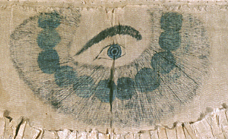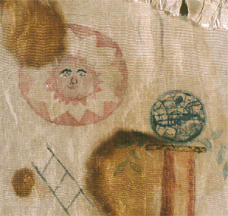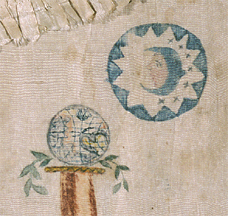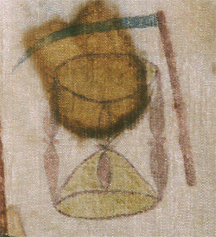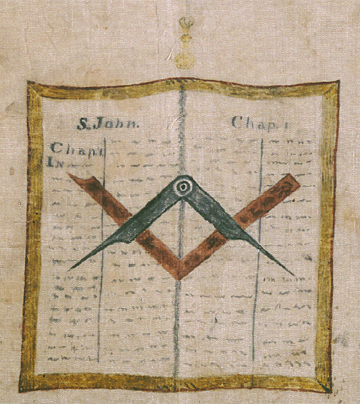To fully understand the enigmatic Meriwether Lewis, an examination of his tenure as Master Mason is warranted.
In Egypt and India, since long before Old Testament times, this has been a symbol not of God himself, but of His omnipresence, and of His powers that are the most important to mankind: love, justice, and mercy. In modern Masonic ritual the All Seeing Eye is often combined with a sword pointing to a naked heart, to symbolize divine justice as well as the ever present Universal Intelligence.
The Masonic apron represents the ancient stone-mason’s craft, which is the allegorical model upon which rest the symbolism and ritual of Freemasonry. The ancient craftsmen were “operative” or working stonemasons; members of the fraternity known as the Ancient Free and Accepted Masons (AF & AM) are “speculative” masons. Through speculative Masonry, wrote Thomas Smith Webb in 1797, “we learn to subdue the passions, act upon the square, keep a tongue of good report, maintain secrecy, and practice charity.” Charity is “the chief of every social virtue,” he continued, “and the distinguishing characteristic of our Order.”[1]Thomas Smith Webb (1771-1819), The Freemason’s Monitor (Albany, New York: Spencer & Webb, 1797), 10, 21. Webb’s influential book furthered the expansion of Freemasonry in the U.S. … Continue reading
Each initiate, upon entering the Order, receives a symbolic apron, which is to be worn during all Masonic meetings and rituals. This apron of Lewis’s, made of hand-painted silk backed with linen, measuring 14½ by 16½ inches, is said to have been in a pocket of his coat when he died. It was passed down from his mother to his sister, Jane, and through her descendants to the Grand Lodge of Missouri, whence it was purchased in 1960 by Joseph Hopper, who donated it to the Montana Masonic Foundation of the Grand Lodge, Ancient Free and Accepted Masons of Montana, in Helena.
Symbolic Meanings
The meanings of some of the symbols on the apron are open to varying interpretations in different Masonic jurisdictions (states or countries) at different times. The following are those currently held by the Grand Lodge AF&AM of Montana, provided through the courtesy of Reid Gardiner, Grand Secretary. They date back to the early 18th century.
Solomon’s Temple
The two pillars of the porch of Solomon’s temple represent strength and stability.[2]“And [Solomon] reared up the pillars before the temple, one on the right hand, and the other on the left; and called the name of that on the right hand Jachin, and the name of that on the left … Continue reading The pillar at left stands for Boaz, interpreted by some Biblical scholars as meaning “in strength”; that on the right symbolizes Jachin, or “God will establish” (1 Kn. 7.21; 2 Chr. 3.17). They represent, respectively, the Senior and Junior Wardens of the Lodge. The pillars rest on three stone steps that symbolize the three ages of man —youth, manhood, and old age—and the three corresponding degrees of the Order. The lowest represents the Entered Apprentice, who is obliged to occupy his mind industriously in the attainment of useful knowledge. The second step stands for the Fellow Craft Mason, who is charged to use his knowledge in the discharge of duty to God, to his own neighbor, and to himself. The topmost step is that of old age, when the Master Mason may “enjoy the happy reflections consequent on a well-spent life, and die in the hope of glorious immortality.”
Skull and Crossbones
The skull and crossbones is an ancient symbol for death. The comparative crudeness of this example, and the fact that it does not belong in the overall symmetry of the design, suggests that it might have been added after the owner’s demise.
Bible
At the center of the apron the Bible is open to Chapter 1, Verse 1—”In the beginning was the Word”—of the Gospel according to St. John, the patron saint of Freemasonry. Superimposed is the square that an operative mason would use for testing angles; to the speculative Mason it stands for justice. Atop the square is a compass or divider, which the former employed for measuring equal lines, the latter for restraining prejudice.
Candlesticks
Faintly seen on each side and above the Bible are single candles in brass candlesticks, which represent the three stages of the sun and the seats of the three main officers and guides of a Lodge. At one side is the rising sun represented by the Worshipful Master, whose seat is on the east side of the Lodge; above is the mid-day sun in the south, where the Junior Warden is seated; on the west side is the setting sun, represented by the Senior Warden’s chair.
Details
Figure 3
Sun
Detail from Lewis’s Masonic Apron
The sun is one of the Lesser Lights, and the symbol of a Master Mason. The ladder is the stairway to heaven as seen by Jacob in a vision (Genesis 28:10). Its three rungs represent Faith, Hope, and Charity. The globe rests on branches from an acacia tree, symbolizing immortality.
Figure 4
Moon
Detail from Lewis’s Masonic Apron
The moon, another Lesser Light, and an emblem of Wisdom, looks out from among the seven stars of the constellation Pleiades, a focal point in the Heavens (Job 9:8-9; Amos 5:8; Job 38:31-32). The figures on this globe and the one opposite represent Heaven and Earth, respectively.
Figure 5
Smooth Ashlar
Detail from Lewis’s Masonic Apron
At lower center is a perfect or smooth ashlar, “a stone made ready by the workmen to be adjusted by the working tools of the fellowcraft,” representing the state of perfection to be reached by “a virtuous education, our own endeavors, and by the blessing of God.” Next clockwise is an operative mason’s chisel, which represents the tools the speculative mason uses to shape himself into a better individual. Next is a maul used by operative masons to tap stones into place; as a symbol it suggests the process of integrating a speculative mason into the Lodge. Beneath the maul is the working mason’s trowel, symbolically used by the speculative mason to spread the cement of brotherly love and affection. The ruler above the maul represents the 24-hour day “divided into three equal parts devoted to God, usual vocations, and rest.” The two small blue objects between the stone and the maul are said by some observers to be lewises (from Old French lévis), dovetail mortise tools with which large stones could be raised into place with a block and tackle.[3]In England during the 19th Century the son of a Mason was called a lewis because it was his duty to “support the sinking powers and aid the failing strength of his father.” Albert G. … Continue reading
Figure 6
Scythe and Hourglass
Detail from Lewis’s Masonic Apron
The scythe stands for the great leveler, Time. The hour-glass symbolizes past and future, the present being the point of union between the upper and lower cells. The brown stain, one of three large and two small spots (see fig. 1) has been analyzed as blood—perhaps that of Meriwether Lewis.[4]In fact, one of the three brown spots was sampled by Dr. Eldon Chuinard, a past president of the Lewis and Clark Trail Heritage Foundation, and tested by Bernard Pirofsky, M.D., chairman of the … Continue reading
Lewis’s Masonic History
Two years after the Corps of Discovery’s return, Lewis, then the Governor of Louisiana Territory, was instrumental in establishing the first Lodge in St. Louis, and on 16 September 1808, by authority of the Pennsylvania Grand Lodge, he was installed as Master of the new Lodge No. 111. In September of the following year he left the city on what was to be the final journey of his life, first relinquishing his Master’s chair to Frederick Bates, the Secretary of the Territory and acting governor during Lewis’s absences.[5]Ironically, eight years before, Bates had applied for the position of private secretary to the President, but for several reasons, Lewis was chosen instead. Jackson, Letters, 1:134.
The Scribe of the Door to Virtue Lodge No. 44 of the Ancient Free and Accepted Masons in Albemarle County, Virginia, recorded on 31 December 1796, that Lieutenant Meriwether Lewis, on furlough from his Western Pennsylvania post in the U.S. Infantry, “was recommended as a proper person to become a member.” Less than one month later, on 28 January 1797, he was elected to membership, initiated as an Entered Apprentice, and given his apron. On the following evening he was admitted to the second, or Fellowcraft degree, and without further examination, promoted “at sight”—that is, by unanimous ballot—as a Master Mason. Such meteoric progress through the first three degrees of Masonry signified confidence on the part of the most prominent men of Albemarle that the 23-year-old Lewis was similarly destined for moral, civic, and political leadership.
A little more than two months later, on the second or third of April, members of the Door to Virtue Lodge conferred upon Lewis the degree of Past Master Mason. At the same meeting two other leading Virginians were elevated to the same status. They were Peter and Samuel Carr, nephews of Thomas Jefferson, whose son-in-law, Governor Randolph, was also in attendance. On 31 October 1799, Lewis was “Exalted to the sublime degree of a Royal Arch, Superexcellent Mason” at Widow’s Son Lodge[6]The “widow’s son” was Hiram Abiff, the master craftsman in the building of Solomon’s Temple, who was murdered for refusing to reveal the secret “Master’s … Continue reading in Milton, Virginia, a few miles southeast of Charlottesville. On that occasion he was given a Royal Arch apron, which is now at the Missouri Historical Society.
In 1801 Lewis, who had been promoted to the rank of captain in late 1799, became the private secretary to President Jefferson, and in June 1803 received his official orders as commander of the expedition to explore the Northwest.[7]Jefferson to Lewis, 30 June 1803, Jackson, Letters, 1:61-66. Lewis no doubt carried his apron during his preparatory travels, as any wayfaring Mason would have. There is reason to believe, for instance, that he attended a Lodge in Pittsburgh while awaiting the completion of the barge (called the ‘boat’ or ‘barge’ but never the ‘keelboat’) from 15 July 1803 until 31 August 1803. If he carried a Masonic apron on his expedition to the Pacific, which might have been expected of a Mason of his rank undertaking such a hazardous mission, he did so in total secrecy.
Clark also Joins
It was at Lewis’s encouragement, no doubt, that William Clark joined the new Lodge in St. Louis. In fact, Lewis may have begun proselytizing his co-captain during the early months of the expedition. Late in January 1804, Clark copied into his journal a definition of the five senses, from Owen’s Dictionary, which was in the company’s small reference library. The subject was entirely out of context with the expedition’s business at that moment, but the paragraph reads like a précis of a catechism for an Entered Apprentice. Clark’s certificate confirming that status, dated 18 September 1809, is at the Missouri Historical Society; his apron is at the Lodge in St. Charles, Missouri. His funeral service, on 1 September 1838, opened with the full Masonic burial rite.
Additional Sources:
Ray Denslow, Meriwether Lewis: Missoui’s First Royal Arch Mason. Trenton, Missouri, n.p., [c. 1939].
Harold Voorhis, Facts for Freemasons. New York: Macoy Publishing and Masonic Supply Co., 1951.
Moses W. Redding, The Illustrated History of Free Masonry. New York: Redding & Co., 1903.
Notes
| ↑1 | Thomas Smith Webb (1771-1819), The Freemason’s Monitor (Albany, New York: Spencer & Webb, 1797), 10, 21. Webb’s influential book furthered the expansion of Freemasonry in the U.S. during the first two decades of the nineteenth century. More than sixteen thousand copies were sold by 1807, and eight editions were published during the author’s lifetime. |
|---|---|
| ↑2 | “And [Solomon] reared up the pillars before the temple, one on the right hand, and the other on the left; and called the name of that on the right hand Jachin, and the name of that on the left Boaz.” Second Chronicles 3:17; also First Kings 7:21. |
| ↑3 | In England during the 19th Century the son of a Mason was called a lewis because it was his duty to “support the sinking powers and aid the failing strength of his father.” Albert G. Mackey, An Encyclopaedia of Freemasonry and its Kindred Sciences (Chicago: Mason ic History Company, 1925), s.v. “Lewis.” |
| ↑4 | In fact, one of the three brown spots was sampled by Dr. Eldon Chuinard, a past president of the Lewis and Clark Trail Heritage Foundation, and tested by Bernard Pirofsky, M.D., chairman of the Hematology-Criminal Division of the University of Oregon Medical School. For lack of sufficient sampling, the results showed only that the stains were either those of the blood of a human, or a deer. Eldon G. Chuinard, “The Masonic Apron of Meriwether Lewis,” We Proceeded On, vol. 15, no. 1 (February 1989), 16–17. |
| ↑5 | Ironically, eight years before, Bates had applied for the position of private secretary to the President, but for several reasons, Lewis was chosen instead. Jackson, Letters, 1:134. |
| ↑6 | The “widow’s son” was Hiram Abiff, the master craftsman in the building of Solomon’s Temple, who was murdered for refusing to reveal the secret “Master’s word,” and his body was thrown into a grave without proper burial. According to legend, the workmen who found Hiram’s body lifted it out of the pit by using the so-called “Lion’s grip”—”Hand to Hand, Foot to Foot, Cheek to Cheek, Knee to Knee, and Hand in Back”—which, as the secret embrace among Fellow Craftsmen, came to symbolize the Five Points of Fellowship. The name of the Lodge (no longer in existence) at Milton, Virginia, implies that the Five Points of Fellowship and the related symbolism of “raising up” a Fellow Craftsman through the successive degrees of Masonry, were focal points in its ritual. Steven C. Bullock, Revolutionary Brotherhood: Freemasonry and the Transformation of the American Social Order, 1730-1840 (Chapel Hill: University of North Carolina Press, 1996), 11, 25-26. One wonders whether the greasy “fraturnal hug” with which the Lemhi Shoshone welcomed Lewis in mid-August of 1805 reminded him of the Masonic tradition, and whether that coincidence might have inspired his quasi-Masonic birthday meditation of 18 August 1805 (see also Lewis’s Birthday Meditation). The Indian embrace, Lewis recounted on 13 August 1805, was “by puting their left arm over you wright sholder clasping your back, while they apply their left cheek to yours.” |
| ↑7 | Jefferson to Lewis, 30 June 1803, Jackson, Letters, 1:61-66. |
Experience the Lewis and Clark Trail
The Lewis and Clark Trail Experience—our sister site at lewisandclark.travel—connects the world to people and places on the Lewis and Clark Trail.
Discover More
- The Lewis and Clark Expedition: Day by Day by Gary E. Moulton (University of Nebraska Press, 2018). The story in prose, 14 May 1804–23 September 1806.
- The Lewis and Clark Journals: An American Epic of Discovery (abridged) by Gary E. Moulton (University of Nebraska Press, 2003). Selected journal excerpts, 14 May 1804–23 September 1806.
- The Lewis and Clark Journals. by Gary E. Moulton (University of Nebraska Press, 1983–2001). The complete story in 13 volumes.

